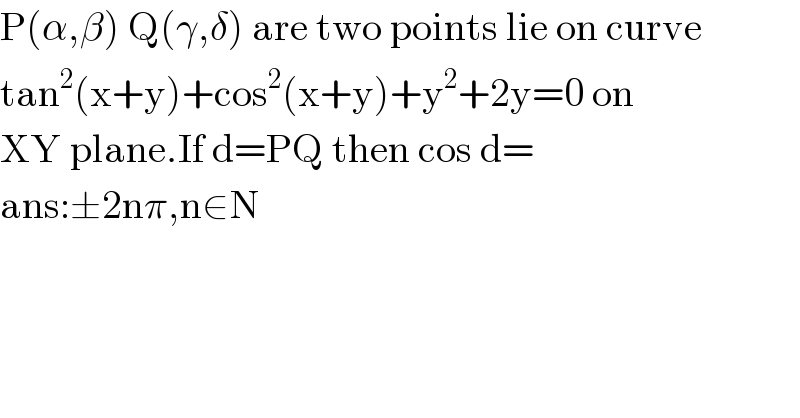
Question and Answers Forum
Question Number 63643 by vajpaithegrate@gmail.com last updated on 06/Jul/19

Answered by MJS last updated on 06/Jul/19
![(d/dy)[y^2 +2y]=2y+2=0 ⇒ y=−1 ⇒ ⇒ y^2 +2y has its minimum at (((−1)),((−1)) ) (d/dt)[tan^2 t +cos^2 t]=2((tan t)/(cos^2 t))−2sin t cos t =0 ⇒ ⇒ t=nπ ⇒ tan^2 t +cos^2 t has its minima at (((nπ)),(1) ) ⇒ the only possibilities for pairs ((x),(y) ) are (((nπ+1)),((−1)) ) two points (((mπ+1)),((−1)) ) and (((nπ+1)),((−1)) ) have the distance d=∣m−n∣π=kπ; m, n∈Z, k ∈N ⇒ cos d =±1](Q63659.png)
| ||
Question and Answers Forum | ||
Question Number 63643 by vajpaithegrate@gmail.com last updated on 06/Jul/19 | ||
 | ||
Answered by MJS last updated on 06/Jul/19 | ||
![(d/dy)[y^2 +2y]=2y+2=0 ⇒ y=−1 ⇒ ⇒ y^2 +2y has its minimum at (((−1)),((−1)) ) (d/dt)[tan^2 t +cos^2 t]=2((tan t)/(cos^2 t))−2sin t cos t =0 ⇒ ⇒ t=nπ ⇒ tan^2 t +cos^2 t has its minima at (((nπ)),(1) ) ⇒ the only possibilities for pairs ((x),(y) ) are (((nπ+1)),((−1)) ) two points (((mπ+1)),((−1)) ) and (((nπ+1)),((−1)) ) have the distance d=∣m−n∣π=kπ; m, n∈Z, k ∈N ⇒ cos d =±1](Q63659.png) | ||
| ||